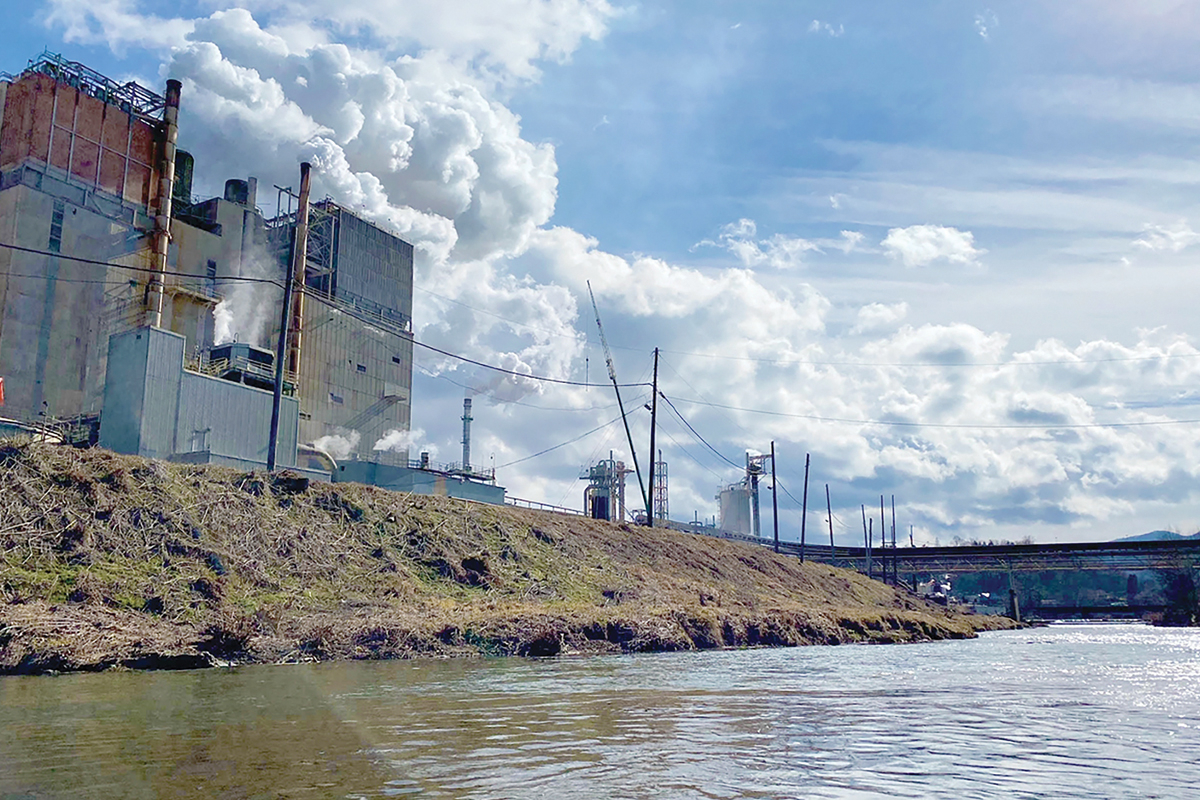Continuing the cleanup: Pigeon River slowly bounces back as mill environmental violations mount
 A kayak-view photo looks upstream from the paper mill site in Canton. Anna Alsobrook/MountainTrue photo
A kayak-view photo looks upstream from the paper mill site in Canton. Anna Alsobrook/MountainTrue photo
Once Pactiv Evergreen’s Canton paper mill shut down for good, people wondered how the Pigeon River and the aquatic life it supports would change.
While the results have been promising with several species seeming to thrive, there is still plenty of room for improvement.
Concerns have grown over what the mill has left behind during its century-plus of operation, and while there are still questions, some answers have emerged as air and water environmental violations have mounted. Pactiv Evergreen has received seven notices of violation from the North Carolina Department of Environmental Quality (DEQ) since it closed last June and 22 since May 2021, an average of about 1.3 every two months.
Some are tied to the shutdown itself, and some have only been revealed in light of the closing. The most recent violations were issued Feb. 2 and Feb. 6 of this year following fecal coliform concentrations in discharge from the wastewater treatment plant back in October of last year.
A few violations, even some of the most recent, are tied to a black-liquor seep dating back to an ongoing problem that first received a notice of violation in 1994. Agency staff have spotted black liquor deposits, a toxic byproduct of papermaking, on multiple occasions since then.
Some violations seem more overt than others. On July 10, a notice of violation (NOV) accused the company of dumping chemicals directly into the mill’s wastewater treatment system rather than disposing of them properly, as required by the company’s permit.
Related Items
According to the NOV, when DEQ’s Department of Water Resources (DWR) discussed the complaint with facility staff, personnel said their actions did not fall outside of regulations contained in Pactiv Evergreen’s National Pollution Discharge Elimination System permit. After DWR told staff that direct disposal of raw materials is not covered under its permit, workers argued that virgin chemicals could be disposed of through the wastewater system, that such activities were allowed within the permit and that “this type of process was inherent to shutdown operations.”
The NOV stated clearly that isn’t case. However, Pactiv countered that claim in a letter it sent to DWR.
“Importantly, the discharge of the cleaning solution and sanitizer to the WWTP [wastewater treatment plant] during the shutdown, both of which were properly discharged to and treated at the WWTP when used in the normal operation of the mill, did not harm the beneficial bacteria or upset the aerobic treatment processes at the WWTP,” the letter states.
“The WWTP did not observe any spikes in pH beyond the anticipated spikes associated with the black liquor discharges,” it later states. “Further, the WWTP complied with all monitored parameters during this period, and no violation of water quality standards was detected.”
Perhaps the most concerning NOV was issued to International Paper and Pactiv Evergreen in the wake of the black liquor seep’s discovery, which spurred various sampling events to understand the extent and impact of the contamination.
In June, Pactiv Evergreen consultant Ensafe sampled the Pigeon River near one of the seepage areas. A preliminary report showed extremely high levels of several heavy metals in one of the sampling sites, a pit dug along the exposed riverbank. Lead levels were 2,796 times higher than the state standard. Copper was 332 times higher, chromium 21 times higher, nickel 17 times higher, zinc five times higher and arsenic nearly four times higher. Beryllium came in more than 30% above the state limit. However, the report noted that the “vast majority” of sites and chemicals analyzed came in below detection limits.
Currently, there are two active cleanups onsite, resulting from issues with above-ground storage tanks. The first is in the wake of a release of gasoline from an underground pump supply line from a tank in early 2021. Oil containment booms were deployed, and three monitoring wells were installed. Pactiv Evergreen must continue operating them until contaminant concentrations fall below regulatory standards.
The second was a release of No. 6 fuel oil that was observed on the Pigeon River in June 2021. The source was determined to be either a tank or transfer line on site. Oil booms were deployed, and a firm engaged for a subsurface investigation. But in August 2022, an oil sheen was once more observed on the river, presumed to be from the same source.
While some issues were noticed because of the shutdown, the tally of violations had been running up years before the announcement that the mill was closing, even beyond the existing black liquor seep. In November 2022, SMN reported that complaints poured into Asheville’s DEQ office alleging that a strange white dust from the mill was covering vehicles. It was believed that the problem sprung up because of a faulty dust collection system.
“This morning a strange, thick white fog appeared that left a gritty, fine white powder on both sides of my vehicles,” one complaint read. “Even after a thorough car wash, the grit remains.”
“What have we been breathing, who is handling the damage to our vehicles and our persons, are there long-term effects we need to be concerned about?” another complaint read.
Even as it’s struggled to control dust deposition, Evergreen has logged multiple water quality violations over the past year and a half. On Nov. 23, 2021, the mill’s environmental staff found dead fish and trace amounts of foam downstream. At the same time, a discharge monitoring report found that biological oxygen demand — the amount of oxygen aquatic microorganisms use up — was higher than allowed under state regulations, posing a problem for native aquatic species. DWR issued two notices of violation, one focusing on the biological oxygen demand exceedance and the other citing five specific water quality violations surrounding the fish kill.
As the mill has accumulated violations, DEQ has continued to make it clear it plans on holding the company accountable. During a visit from NCDEQ Secretary Elizabeth Biser in May, she said she wants to use “all authority and available resources” to ensure a full environmental assessment is conducted.

Haywood County Republican Rep. Mark Pless (left) speaks on Aug. 17 in Canton with Elizabeth Biser, secretary of North Carolina’s Department of Environmental Quality. Cory Vaillancourt photo
“Notices of violation are what we use whenever there are violations that are observed or are noted,” Biser said during a separate August visit. “Those evaluations, I believe, so far have spoken for themselves. We will continue to hold Pactiv accountable as we do all actors in the state.”
Canton Mayor Zeb Smathers said he’s appreciated Biser and DEQ’s analysis and accountability.
“From zero-hour, DEQ has been an absolutely tremendous partner for the town and the county,” Smathers said. “The solutions are workable, but they’re making [Pactiv] Evergreen do what they’re supposed to, and we expect that to continue.”
While concerns continue over contamination related to ongoing cleanups, there is also good news. A DEQ survey of aquatic creatures conducted downstream from the mill site in August of last year yielded the first-ever “good” bioclassification at that site in the 39 years and 17 observations on record. In addition, in July of last year, the N.C. Wildlife Resources Commission sampled fish populations at three sites downstream from the mill and found double the diversity and 15 times the number of fish logged during a previous sampling event in May, when the mill was still operating.
When the mill was operational, the water it released was warmer than the water it took in. Data gathered in preparation for the permit renewal showed that between 2016 and 2018, the average temperature difference was 6 degrees. There were 161 days with a temperature difference greater than 10 degrees, and 118 days with downstream water temperatures greater than 80 degrees. One day in 2016 when the river above the mill measured 77 degrees, the downstream reach marked its peak temperature of 90 degrees. For a mountain stream, anything over 80 degrees is incredibly warm.
This lines up with what environmental groups hoped to see following the shutdown. Those groups have envisioned a Canton that can pay homage to its blue-collar roots while shifting its economy to put outdoor recreation front and center. Now, some believe the potential to attract paddlers and anglers might lie ahead.
Luke Etchison, a river conservation biologist for the North Carolina Wildlife Resources Commission, said that while they were hoping to get out in the fall for further analysis, they weren’t able to, but biologists do plan on going late spring or early summer of this year to continue sampling. Anecdotally, he said it seems like many species had great years, and he believes the cause is likely the closure of the mill. While there were some species that didn’t seem to have a noticeable change, Etchison thinks they may see signs of that this year.
“We have some species for which the peak is typically early May, so the fact that we didn’t find any juveniles before made me think they just didn’t have the opportunity to spawn,” he said, adding that they also plan to reintroduce certain species. “We can start doing some of the stuff we were doing in the upper French Broad River here.”
Going forward, the concern is that further analysis may turn up PFAS, a potentially harmful chemical that breaks down slowly. PFAS is often used in the paper industry, especially for food product packaging like that made in the Canton plant. If so, the PFAS could also be buried at the mill’s landfills. If those chemicals leach into the ground from those landfills, serious problems could arise.
The group conducting research to monitor for PFAS and other toxic substances is the N.C. Collaboratory out of UNC Chapel Hill.
The purpose of the testing is not so much to assign blame for the presence of any contaminants found (it’s difficult to prove how a particular chemical came to be present in a sample) and to force a suspected polluter to clean it up, but rather to develop a “to do” list of issues to be addressed.
To start, the project will likely extend 18-24 months, but the effort may ultimately last longer than that — closer to 36 months. The Collaboratory, which is planning the project in partnership with the DEQ, anticipates investing $250,000 to $500,000 over time.













